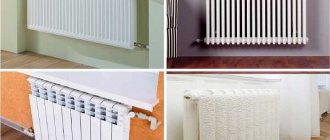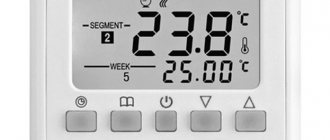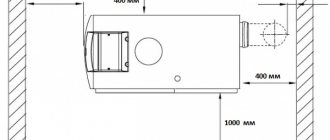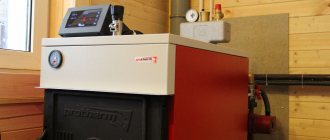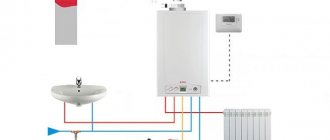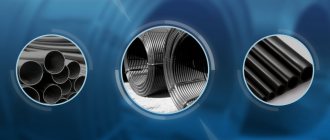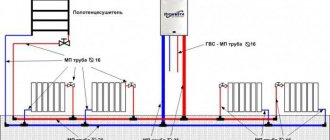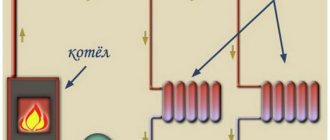The temperature of the coolant in the heating system depends on the air temperature outside, it is maintained according to the temperature schedule developed by experts for each heat supply source in different ways, it all depends on local weather conditions. These schedules are designed so that even at very low air temperatures outside, a comfortable temperature for people, about 20-22 ° C, is maintained in the dwellings.
How warm should the room be?
The list of temperatures in various rooms provided for by the standard:
- living room - + 18 ° C;
- corner room - + 20 ° C;
- kitchen - + 18 ° C;
- bathroom - + 25 ° C;
- lobby and staircase - + 16 ° C;
- lift room - + 5 ° C;
- basement - + 4 ° C;
- attic - + 4 ° C.
- rooms intended for children - from + 18оС to + 230С.
- pools - not lower than + 300C;
- verandas for walking - not lower than + 120C;
- children's schools - not lower than 210C;
- bedrooms of boarding schools - not lower than 160C;
- cultural institutions - from 160C to 210C.
- libraries - up to 180C.
This temperature is measured on the inner wall of each room, the main condition for this event is that the distance from the outer wall should be 1 m, and 1.5 m from the floor.
The room should have a certain rate of air exchange, for example, the living room area is 18 or 20 m2, in this case the rate should be 3m3 / h per 1m2, the same characteristics should be observed in regions where the thermometer drops below - 31oC.
In the kitchens of the hostel and apartments, which are equipped with gas and electric stoves with two burners, whose area reaches 18 m2, aeration should be 60 m3 / h. In the event that there are three hotplates in the room, the aeration must accordingly be increased to 75 m3 / h, and when the burner is four, this characteristic must be increased to 90 m3 / h.
Bathrooms whose area is 25 m2, the rate of aeration should be 25 m3 / m2, and for an individual toilet whose area is 18 m2 - 25 m3 / h. In the event that the bathroom is combined, the air exchange must be at least 50 m3 / h, and if an urinal is still installed in it, then it is necessary to add another 25 m3 / m to it.
In the case when the room is corner, the temperature in the room should be 2o higher than usual.
In warm weather, the elevator room should not exceed 40 ° C.
In the event that hourly deviations from the established characteristics are noticeable, the fee should be reduced by 0.15%.
How to measure the temperature of the heating medium?
The temperature of the coolant in the heating system provides for the following standards:
- Hot water in the tap should be available all year round and its temperature should be from + 50 ° C to + 70 ° C;
- Heating devices are filled with this liquid during the heating season.
In order to find out the temperature of the heating radiator, you need to open the tap and substitute a container with a thermometer. During this time, the temperature may rise by 4 ° C.
When a problem arises in this matter, it is tedious to file a complaint with the housing office, but in the case of airing the batteries, the complaint is written in the DEZ. A specialist should come within a week to fix everything.
There are several more ways to measure the temperature of heating batteries in an apartment building:
- With the help of a thermometer, the temperature of the heating pipes or the radiators themselves is measured; 1-2 ° C must be added to the result obtained;
- For more accurate data measurement, you need to buy a thermometer-pyrometer, which is able to measure the temperature with an accuracy of 0.5 ° C;
- It is necessary to take an alcohol thermometer and attach it to a certain place on the heating battery, after which it is wrapped with tape and wrapped with any thermal insulator (foam rubber, flywheel). Now it will play the role of a permanent meter of the heating system temperature;
- In the event that an electronic measuring device is at hand, for example, a multimeter, with a temperature measurement function, a wire with a thermocouple is tied to the radiator, and the temperature of the coolant is measured.
If you are not satisfied with the temperature of your heating devices or any other parameters of the coolant, then after filing a complaint, a commission will come to you, whose task will be to measure the temperature of the circulating liquid in the heating system.
They must strictly act in accordance with paragraph 4, which is specified in the "Methods of control" GOST 30494−96, and the device must have registration, as well as certificates of verification and quality. The measurement range should vary from +5 to + 40 ° C, the permissible error should be within 0.1 ° C.
What does the temperature depend on?
There are several other factors that affect the indoor temperature:
- If the outside air temperature is low, accordingly, it will be lower in the room;
- Wind speed also affects temperature. The stronger the wind loads, the more heat loss will be through windows and entrance doors;
- Tightness of sealing joints in the walls of the house. For example, metal-plastic windows and insulation of front walls can significantly affect the temperature inside the home.
Everything described earlier is undoubtedly important. But, the main factor that strongly affects the temperature in the rooms is the temperature of the heating radiators themselves. Typically, heating batteries supplied from the central system have a temperature of 70 - 90 ° C.
It is known that the required temperature inside the room cannot be achieved only by this factor, taking into account the fact that in different rooms there should be different temperature conditions due to their different purpose.
The temperature regime inside the room is also influenced by how intense the movement of people inside it. The temperature will be higher where people move the least.
Read more: How to invalidate the apartment gulf act
This is the basis for heat distribution. As proof, in sports facilities, where people are constantly moving, the temperature is maintained at 18 ° C, since it is not advisable to maintain a higher temperature.
Factors influencing the temperature of radiators:
- Outside temperature;
- Heating system type. Norm of a one-pipe system: +105 ° C, for a two-pipe system: + 95 ° C. The difference between supply and return should not be more than 105 - 70 ° C and 95-70 ° C, respectively;
- Directions of the coolant flow into the batteries. In the case when the wiring is from above, the difference will be: + 20 ° C, from below - +30 ° C;
- Heating device type. Radiators and convectors differ in heat transfer, which means that the temperature regime is also different. Convectors have a lower heat transfer than radiators.
It is natural for everyone to understand that regardless of whether it is a convector or a radiator, heat transfer will directly depend on the temperature outside. At zero outside temperature, the heat transfer rate of the radiators should vary within 40-45 ° C supply and 30-35 ° C return. For convectors, these characteristics are as follows: 41-49 ° C supply and 36-40 ° C return.
When the thermometer falls to -20 ° C, these characteristics will be as follows: for radiators - supply 67-77 ° C, return 53-55 ° C, for convectors - supply 68-79 ° C and return 55-57 ° C.But when the thermometer reaches -40 ° C, both radiators and convectors will have the same characteristics: supply 95-105 ° C, return temperature 70 ° C.
How are rates calculated?
As described above, the temperature graph is directly affected by the outside air temperature. Accordingly, the lower the outside temperature, the greater the heat loss. The question arises, what indicators to use for the calculation?
This indicator can be found in regulatory documents. It is based on the average temperature of the five coldest days of the year. A period of 50 years is taken into account and the 8 coldest winters are selected. For what reasons is the average daily temperature calculated in this way?
Firstly, thanks to this, it is possible to be prepared in winter for low temperatures, which occur every few years. In addition, given these indicators, you can significantly save on costs during the creation of heating systems. In the case of mass construction, this amount will be very significant.
Accordingly, the temperature of the coolant will directly affect the temperature of the heated room.
Based on the street temperature indicators, calculations of the coolant temperature are made and have the following values:
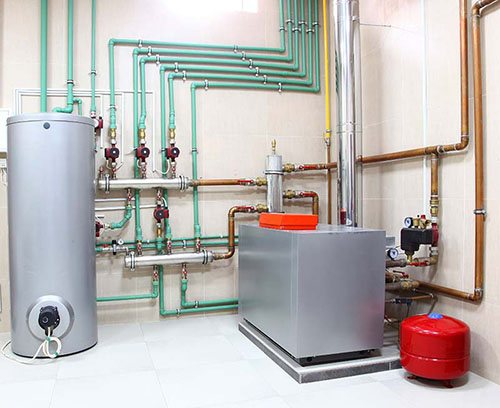
In order to comfortably survive the cold season, you need to worry about creating a high-quality heating system in advance. If you live in a private house, you have an autonomous network, and if in an apartment complex, you have a centralized one. Whatever it is, it is still necessary that the temperature of the batteries during the heating season be within the standards established by SNiP. Let us analyze in this article the temperature of the coolant for different heating systems.
The heating season begins when the average temperature on the street per day drops below + 8 ° C and stops, respectively, when it rises above this mark, but at the same time it also lasts up to 5 days.
Standards. What temperature should be in the rooms (minimum):
- In a residential area + 18 ° C;
- In the corner room + 20 ° C;
- In the kitchen + 18 ° C;
- In the bathroom + 25 ° C;
- In corridors and stairwells + 16 ° C;
- In the elevator + 5 ° C;
- In the basement + 4 ° C;
- In the attic + 4 ° C.
It should be noted that these temperature standards refer to the heating season and do not apply to the rest of the time. Also, information that hot water should be from + 50 ° C to + 70 ° C will be useful, according to SNiP-u 2.08.01.89 "Residential buildings".
There are several types of heating systems:
The effect of temperature on the characteristics of the coolant
In addition to the factors listed above, the temperature of the water in the heat supply pipes affects its characteristics. The method of functioning of gravitational heating systems is based on this. With an increase in the value of water heating, it expands and circulation appears.
Heating media for the heating system
But when using antifreeze, exceeding normal temperatures in the heating batteries can lead to different results. Therefore, for heat supply with a heat carrier that differs from water, it is necessary first to determine the permissible values of its heating. This does not apply to the temperature of the central heating radiators in the apartment, since such devices do not use antifreeze-based liquids.
Antifreeze is used if there is a risk of exposure to low temperatures on the radiators. Unlike water, it does not go from a liquid to a crystal-like state at a value of 0 degrees. But if the work of heat supply goes beyond the norms of the temperature table for heating in a larger direction, the following phenomena can be observed:
- foaming. This contributes to an increase in the volume of the coolant and the pressure level. There will be no reverse process when the antifreeze cools down;
- the appearance of limescale.The antifreeze contains mineral components. If the heating temperature in the apartment is violated, they precipitate. Over time, this leads to clogging of pipes and radiators;
- an increase in the density index. Malfunctions in the operation of the circulation pump may occur if its rated power was not designed for such situations.
We recommend: Which radiators are best suited for autonomous heating?
Therefore, it is much easier to monitor the temperature of the water in the heating system of a private house than to control the heating level of antifreeze. Moreover, substances based on ethylene glycol emit gas harmful to humans when evaporated.
Today they are almost never used as a coolant in autonomous heat supply systems. Before using antifreeze in heating, it is necessary to replace all rubber seals with paranitic ones. This is due to the high level of permeability of this type of coolant.
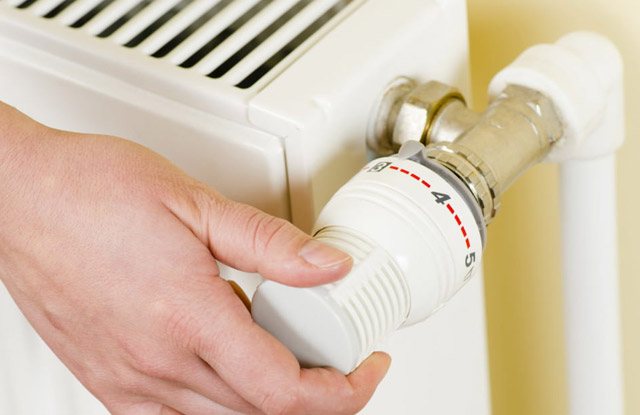

Options for normalizing the temperature regime of heating
The minimum indicators of the water temperature in the heating system are not considered the main threat to its operation. This affects the microclimate in living rooms, but does not affect the operation of the heat supply. If the water heating rate is exceeded, emergency situations may occur.
Safety group for autonomous heating
When creating a heating scheme, it is necessary to provide a list of measures aimed at preventing a critical increase in water temperature. First of all, this will lead to an increase in pressure and stress on the inside of the pipes and radiators. If this happened once and lasted a short time, then the details of the heat supply will not be affected.
But such cases appear with the constant influence of specific factors. Most often this is the improper operation of a solid fuel boiler. To avoid breakdowns, it is necessary to upgrade the heating in this way:
- installation of a security group. It consists of an air vent, a drain valve and a pressure gauge. If the water temperature reaches a critical level, these parts will eliminate the excess of the coolant, thereby ensuring normal circulation of the liquid for its natural cooling;
- mixing unit. It connects the return and supply pipes. Additionally, a two-way valve with a servo drive is mounted. The latter is connected to a temperature sensor. If the indicator of the heating level exceeds the norm, the valve will open and there will be a mixing of streams of hot and cooled water;
- electronic heating control unit. It distributes the temperature of the water to different parts of the system. In case of violation of the thermal regime, it sends a corresponding signal to the boiler processor to reduce the power.
These measures will prevent incorrect operation of the heating even at the initial stage of the appearance of the problem. The most difficult thing to control is the water temperature in systems with a solid fuel boiler. Therefore, for them, special attention must be paid to the choice of indicators of the safety group and the mixing unit.
YouTube responded with an error: Access Not Configured. YouTube Data API has not been used in project 268921522881 before or it is disabled. Enable it by visiting https://console.developers.google.com/apis/api/youtube.googleapis.com/overview?project=268921522881 then retry. If you enabled this API recently, wait a few minutes for the action to propagate to our systems and retry.
- Similar posts
- How to choose central heating batteries?
- Can aluminum radiators be installed on central heating?
- How do solar panels work for home heating?
- What are the best radiators for central heating?
- How to install balcony heating from central heating?
- How to repair aluminum radiators with your own hands?
Natural circulation
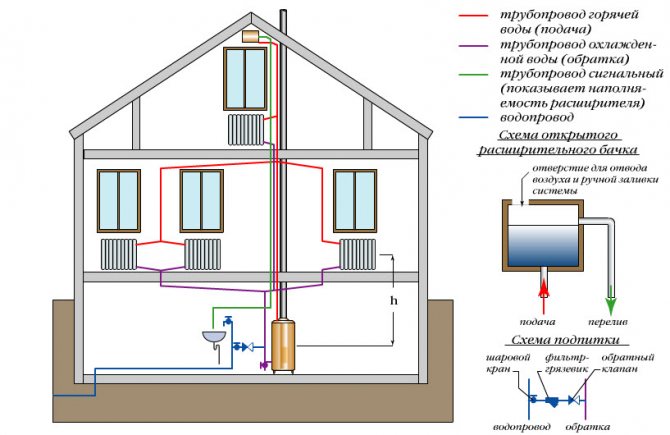

The coolant circulates without interruption. This is due to the fact that the change in temperature and density of the coolant occurs continuously. Because of this, heat is distributed evenly over all elements of the natural circulation heating system.
The circulating water pressure directly depends on the temperature difference between hot and cooled water. Typically, in the first heating system, the coolant temperature is 95 ° C, and in the second 70 ° C.
Setting the weather regulation on the boiler
In order for the temperature in the house to remain constant, the temperature of the heating water in the system, when the outside temperature changes, must change according to a certain law. This pattern is determined by the magnitude and nature of the building's heat loss, as well as the parameters of the heating system.
The dependence of the heating water temperature on the outside temperature is shown on the graph by the heating curve. The slope of the heating curve is very individual for each building.
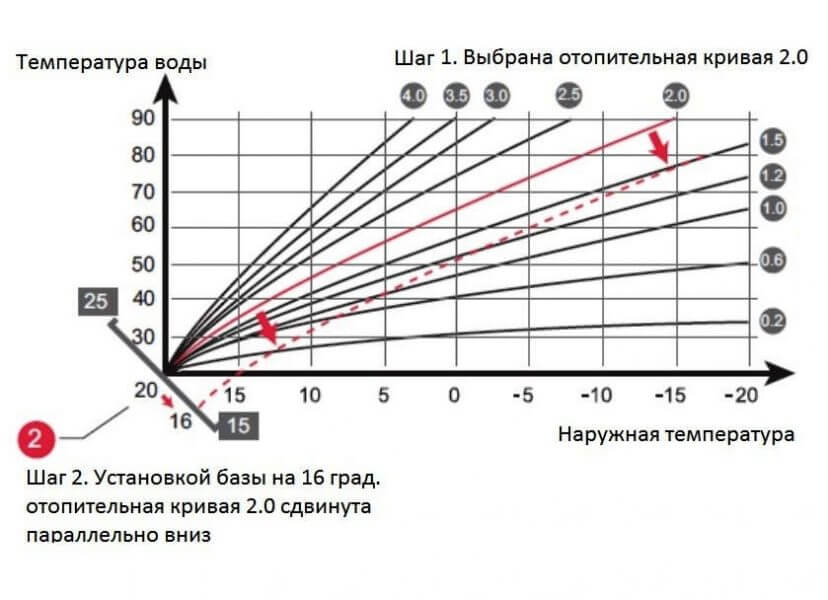

Heating curves for some parameter values in line d.43 of the service menu of the Protherm Gepard (Panther) boiler ..
To work with an outside temperature sensor connected to the boiler, the heating curve for the house is selected in two steps.
Step 1. In line d.43 of the service menu, select the parameter that sets the slope of the heating curve (in the graph above). Parameter factory setting = 1.2. Select the parameter that corresponds to the heating curve passing through the known intersection point on the heating water temperature and outside temperature graph. These temperatures (this point) are determined by calculation. Often no calculations are made and this point is not known in advance.
Usually, the parameter of the slope of the heating curve in line d.43 is selected empirically. Leave the factory setting of the parameter in line d.43 and observe in which direction the room temperature changes when the outside temperature fluctuates. If, when the outside temperature drops, the room temperature rises, then it is necessary to reduce the slope of the heating curve, i.e. decrease the value of the parameter in line d.43, and vice versa. The task is to choose such a parameter value at which a change in the outside temperature will not lead to temperature fluctuations in the house. At this step, the main thing is to achieve a stable temperature in the room, regardless of the absolute value of this temperature.
Step 2. In line d.45 of the service menu, select the base temperature of the heating curve in the range of 15 - 25 ° C. Parameter factory setting = 20. The parameter in line d.45 sets the absolute value of the room temperature. If, after selecting the slope of the heating curve in step 1, the room temperature is stable, but low, then the temperature parameter in line d.45 is increased, and vice versa. In this case, the heating curve on the graph rises or falls, but its slope does not change.
If line d.47 is called in the service menu, the display screen will show the temperature, which is measured by the outside temperature sensor.
Read: How to enter the service menu of the Protherm Gepard (Panther) boiler
Forced circulation
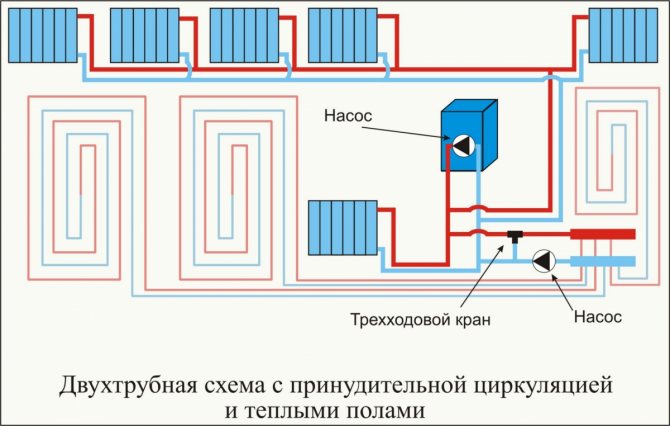

Such a system is divided into two types:
The difference between them is quite large. The piping layout, their number, sets of shut-off, control and control valves are different.
According to SNiP 41-01-2003 ("Heating, ventilation and air conditioning"), the maximum temperature of the coolant in these heating systems is:
- two-pipe heating system - up to 95 ° С;
- one-pipe - up to 115 ° С;
The optimum temperature is from 85 ° C to 90 ° C (due to the fact that at 100 ° C, the water already boils. When this value is reached, you have to use special measures to stop boiling).
The dimensions of the heat given off by the radiator depend on the installation location and the method of connecting the pipes. Heat output can be reduced by up to 32% due to poor piping arrangement.
The best option is a diagonal connection, when hot water comes from the top, and the return flow is from the bottom of the opposite side. Thus, the radiators are checked for testing.
The most unfortunate thing is when hot water comes from below, and cold water from above along the same side.
Air temperature standards in the living quarters of the house
In a private house, when setting up the heating system, it is recommended to be guided by the air temperature standards in the premises, established by "GOST 30494-2011. Interstate standard. Residential and public buildings. Indoor microclimate parameters ":
| The name of a room | Temperature (оС), optimal / permissible |
| Living room | 20-22 / 18-24 |
| The same, but in areas with the outside temperature of the coldest five-day period -31 ° C and below | 21-23 / 20-24 |
| Kitchen, toilet | 19-21 / 18-26 |
| Bathroom, combined bathroom | 24-26 / 18-26 |
| Staircase, lobby | 16-18 / 14-22 |
| Pantry | 16-18 / 12-22 |
In addition to temperature, another important parameter of the indoor microclimate is the relative humidity. The standard also regulates the relative air humidity during the heating period for living rooms is optimal at 45-30%. The permissible air humidity in all rooms of the house should not exceed 60%.
Measurement of air temperature and humidity should be carried out in the center of the room at a height of 1.7 m, in cloudy weather and the outside air temperature is below -5 ° C.
Optimal microclimate parameters - a combination of values of microclimate indicators, which, with prolonged and systematic exposure to a person, provide a normal thermal state of the body with a minimum stress of thermoregulation mechanisms and a feeling of comfort for at least 80% of people in the room.
Permissible microclimate parameters - a combination of values of microclimate indicators, which, with prolonged and systematic exposure to a person, can cause a general and local feeling of discomfort, a deterioration in well-being and a decrease in working capacity with increased tension of thermoregulation mechanisms and do not cause damage or deterioration in health.
In residential buildings, in accordance with SP 60.13330.2010 "SNiP 41-01-2003 Heating, ventilation and air conditioning" during the cold period of the year, when there are no people in them, it is allowed to reduce the microclimate indicators, taking the air temperature below the standard, but not below: 15 ° С - in residential premises; 12 ° С - in public, administrative and household premises. The normalized temperature in the premises must be ensured before the start of use.
In the basement of the house, the air temperature should not be lower than +5 ° C.
Tips for the developer
How to reduce the high gas consumption by the boiler for heating the house:
- Choose the power of one gas boiler, the minimum required to compensate for heat losses at home. When installing two boilers, their total total power must be equal to the minimum required.
- In order to save gas and comfort, it is advantageous to use a heating and hot water supply system with a single-circuit boiler and a boiler. With a heating system power of less than 15 kW. it is better to refuse the use of a double-circuit boiler, a system with a boiler will be most profitable.
- Choose a gas boiler with an open combustion chamber, atmosphere.
- When choosing a boiler brand, among other characteristics, be sure to evaluate the boiler efficiency specified in the technical documentation.
- Clean the soot from the boiler heat exchanger annually.
- Check the function and immediately eliminate any defects in the air supply and flue gas discharge of the boiler.
- Be sure to connect a room thermostat and an outdoor temperature sensor to the boiler. Installing a simple two-point thermostat and outdoor temperature sensor will pay off in one to two years.
- Install a thermostatic valve for each radiator in all rooms (except for the room with a room thermostat). This will allow avoiding overheating in many rooms and keeping the temperature lower.
- Rooms with underfloor heating should be equipped with automatic room temperature controllers with protection against floor overheating.
Only in this way, bit by bit, by fulfilling these conditions, it is possible to reduce to a minimum the gas consumption associated with the operation of the heating system.
Calculation of the optimal temperature of the heater
Most importantly, the most comfortable temperature for human existence is + 37 ° C.
Read more: Is it possible to divorce a pregnant woman without the consent of her husband
When choosing a radiator, you need to calculate whether the thermal power of the device is enough to heat the room. There is a special formula for this:
S * h * 41: 42,
- where S is the area of the room;
- h is the height of the room;
- 41 - minimum capacity per 1 cubic meter S;
- 42 - nominal thermal conductivity of one section according to the passport.
Please note that a radiator placed under a window in a deep niche will give almost 10% less heat. The decorative box will take 15-20%.
When you use a radiator to maintain the required room temperature, you have two options: you can use small radiators and increase the water temperature in them (high temperature heating), or you can install a large radiator, but the surface temperature will not be so high (low temperature heating) ...
With high temperature heating, the radiators are very hot and burns if touched. In addition, at a high temperature of the radiator, the decomposition of the dust deposited on it can begin, which will then be inhaled by people.
When using low-temperature heating, the appliances are slightly warm, but the room is still warm. In addition, this method is more economical and safer.
Cast iron radiators
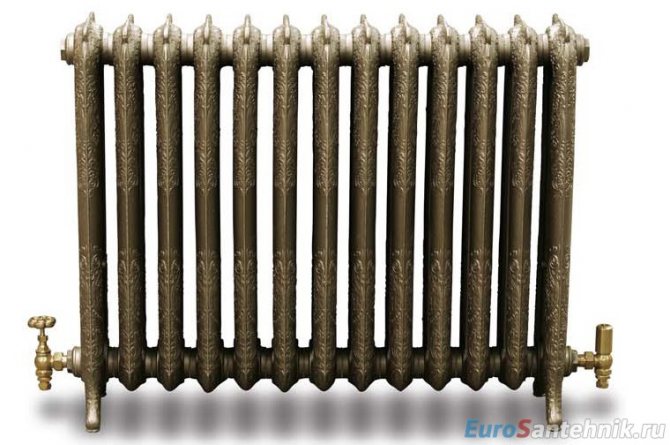

The average heat output from a separate section of a radiator made of this material is from 130 to 170 W, due to the thick walls and the large mass of the device. Therefore, it takes a long time to warm up the room. Although there is a reverse plus in this - a large inertia ensures a long retention of heat in the radiator after the boiler is turned off.
The coolant temperature in it is 85-90 ° C
Aluminum radiators
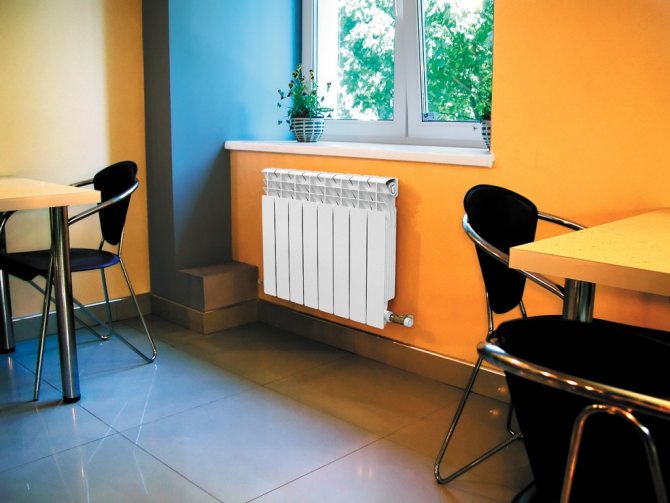

This material is lightweight, easy to heat up and with good heat dissipation from 170 to 210 watts / section. However, it is negatively affected by other metals and may not be installed in every system.
The operating temperature of the coolant in the heating system with this radiator is 70 ° C
Steel radiators
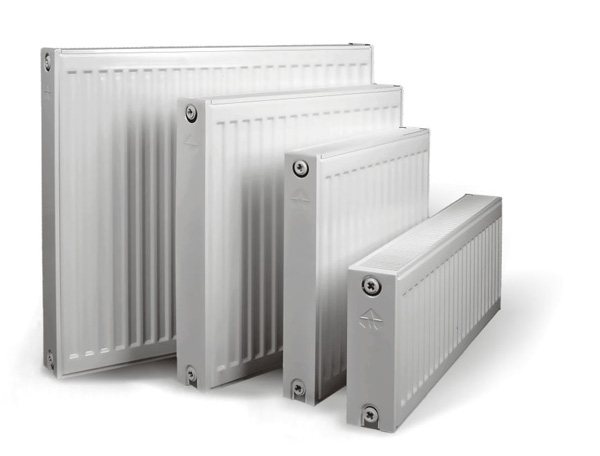

The material has an even lower thermal conductivity. But by increasing the surface area with partitions and ribs, it still heats well. Heat output from 270 W - 6.7 kW. However, this is the power of the entire radiator, and not of its individual segment. The final temperature depends on the dimensions of the heater and the number of fins and plates in its design.
The operating temperature of the coolant in the heating system with this radiator is also 70 ° C
So which one is better?
Probably, it will be more profitable to install equipment with a combination of the properties of an aluminum and steel battery - a bimetallic radiator. It will cost you more, but it will also last longer.
The advantage of such devices is obvious: if aluminum withstands the temperature of the coolant in the heating system only up to 110 ° C, then bimetal up to 130 ° C.
On the contrary, heat dissipation is worse than that of aluminum, but better than that of other radiators: from 150 to 190 W.
Warm floor
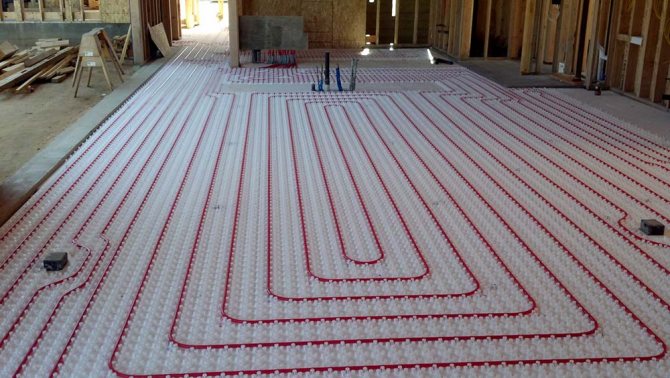

Another way to create a comfortable temperature environment in the room. What are its advantages and disadvantages over conventional radiators?
From the school physics course, we know about the phenomenon of convection. Cold air tends downward, and when it heats up, it rises up. Therefore, by the way, my feet are freezing. The warm floor changes everything - the air heated below is forced to rise up.
Such a coating has a large heat transfer (depending on the area of the heating element).
The floor temperature is also spelled out in SNiP-e ("Building norms and rules").
In a house for permanent residence, it should not be more than + 26 ° С.
In rooms for temporary stay of people up to + 31 ° С.
Institutions where classes with children are held, the temperature should not exceed + 24 ° C.
The operating temperature of the coolant in the underfloor heating system is 45-50 ° C. Surface temperature on average 26-28 ° С
Room thermostat saves gas
For automatic control of the temperature in the house, boiler manufacturers recommend using room or weather-compensated controller with continuous temperature control principle boiler flow.
Also, you can use two-point principle room thermostat (ON / OFF), but with less efficiency.
Luxury boilers, as a rule, are immediately equipped with a remote control unit. Mounted on the wall of a room, such a unit allows remote control and monitoring of the boiler, and also serves as a room thermostat.
The room regulator allows you to maintain a constant temperature in the heated room with high accuracy. With manual control, the range of temperature fluctuations is larger and deviations are more often in the direction of a higher temperature. Every extra degree in the room leads to an increase in gas consumption for heating. In addition, with the help of the thermostat, you can program an automatic decrease in the temperature in the house in certain periods (at night ...). Refusal of manual control of the heating temperature and installation of an automatic regulator to maintain the required temperature in the room, allow significantly reduce gas consumption for heating.
In addition, the owner does not need to run to the boiler room to change the boiler settings. Custom boiler settings can be changed right in the house, on the thermostat.
A room thermostat or room thermostat temperature sensor is always installed in the largest room in a house or apartment.
Room thermostat saves energy
When the boiler is operating without a room thermostat, the circulation pump runs constantly, consuming electricity. The room thermostat controls not only the gas burner, but also the circulation pump. The circulation pump, controlled by a room thermostat, operates intermittently, which saves energy and pump life.
Comments (1)
Andrew
12/13/2017 at 07:51 | #
Ladies and gentlemen! I got it in the fall from, through dealers, convectors built into the windowsill - 3 pieces (one 3m, the other 2 by 1.2m). I installed them in a window sill with a depth of 50 cm, the heating season began and it turned out that they did not even heat up. We have a townhouse of 4 floors, I live on the fourth, the 5th floor is supposed to be, there is a boiler, it is fired with coal. I have water heating in the floor. The floor is warm enough, but as for the convectors, they are slightly warm and, accordingly, do not cut off cold air. The temperature in the comb reaches a maximum of 51 degrees, and as your dealers explained to me that this temperature is not enough for the convector, at least 70 degrees is needed, but unfortunately if our boiler delivers 80 degrees, then it will be very hot in the lower floors. In this regard, I would like to ask your opinion about what can be done in my case. Can I get convectors and change them to electric ones, although the repair has already been done? Then how much more expensive will it be if you pay the electricity bill? It is possible to install an electric boiler on convectors, although I have very little space in the boiler room and how much will the electricity bill grow? maybe just install wall radiators? Do not misunderstand me, I was advised to put built-in convectors in the window sill, since the window sill is deep, and I, in turn, gave up wall radiators. At the moment, my convectors do not heat up and there are no radiators, which, you must agree, is very offensive. I am writing to you in the hope of an answer and for help. Thank you.
On the supply, it is from 95 to 105 ° C, and on the return - 70 ° C. Optimal values in the individual heating system H2_2 Autonomous heating helps to avoid many problems that arise with the centralized network, and the optimal temperature of the heat carrier can be adjusted in accordance with the season. In the case of individual heating, the concept of norms includes the heat transfer of the heating device per unit area of the room where this device is located. The thermal regime in this situation is provided by the design features of the heating devices. It is important to ensure that the heat carrier in the network does not cool below 70 ° C.An indicator of 80 ° C is considered optimal. With a gas boiler, it is easier to control heating, because manufacturers limit the possibility of heating the coolant to 90 ° C. Using sensors to regulate the gas supply, the heating of the coolant can be controlled.
Heat carrier temperature in different heating systems
It is only important to observe the degree of heating of the air in the room. Therefore, in principle, the operating temperature of one system can be different from another. It all depends on the influencing factors that were mentioned above.
In order to determine what temperature should be in the heating pipes, you should familiarize yourself with the current standards. In their content, there is a division into residential and non-residential premises, as well as the dependence of the degree of air heating on the time of day:
- In the rooms during the daytime.
Read more: Legal advice on labor law in Sokol
Two-position thermostats - thermostats for gas boiler
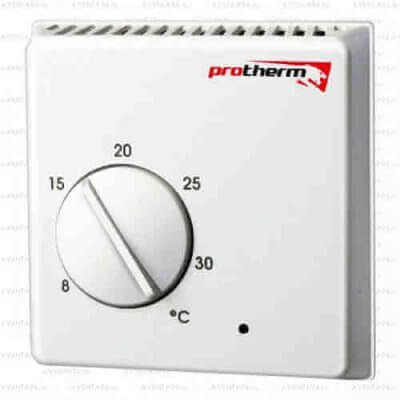

Electromechanical two-position room thermostat Protherm Exabasic for a gas boiler is simple, cheap, but temperature fluctuations in the heated room will be significant - about 2-3 ° C.
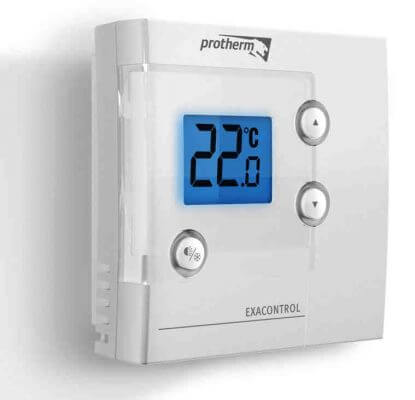

Electronic two-position room thermostat Protherm Exacontrol provides higher accuracy and stability of maintaining the temperature in the room, has a function of protecting the heating system from freezing. The display shows the current room temperature.
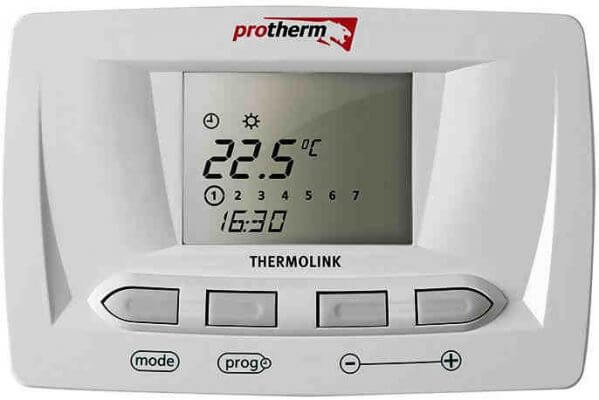

Electronic two-position programmable room thermostat - thermostat Protherm Thermolink S
Thermolink S is an electronic two-position programmable regulator, which differs from previous models in that it allows you to set the temperature according to one weekly program with the possibility of combinations of three different time intervals (morning, afternoon, evening).
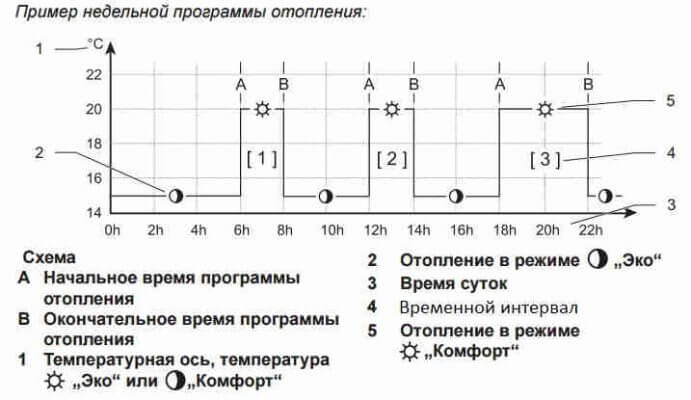

Weekly program for regulating the heating temperature in a house, apartment with a room thermostat Protherm Thermolink S
In addition, it is possible to set one of three temperature modes: "Comfort", "Eco" (economy) or "Vacation" mode.
Thermolink S regulator supports the function of frost protection of the heating system when the room temperature drops to 3 ° C.
The display shows the current room temperature, as well as the time and day of the week.
Features of the boiler with a two-position thermostat
Two-position thermostats have a relay with contacts at the output. Contacts can be in one of two positions: closed or open. Closed thermostat contacts connected to the boiler switch on the boiler heating mode. When the contacts are opened, the heating mode is switched off. The boiler works in cycles - on / off. There are no changes in the heating mode settings on the boiler itself.
The cyclic operation of the boiler under the control of a two-position room thermostat can hide the boiler timing, which occurs due to a significant discrepancy between the capacities of the boiler and heating devices (read the beginning of the article about timing).
Many even argue that the boiler clock can be eliminated not by adjusting the gas valve, but by installing a room thermostat.
However, if the power of the boiler significantly exceeds the power of the heating devices, then the frequency of the boiler operation cycles with a two-position thermostat increases. The boiler switches on and off more often. In addition, the range of temperature fluctuations in the room expands.
Correct setting of the power of the gas boiler is necessary and when the boiler is operating under the control of a room thermostat.
The sensitivity of the electronic two-position room thermostat is 0.5 ° C. The thermostat switches contacts when the room temperature changes by half a degree.
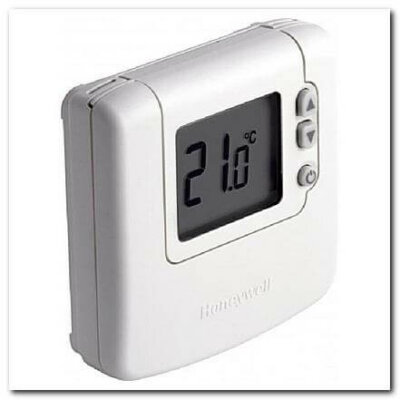

The two-position room thermostat uses self-learning algorithm TPI - regulation... Fuzzy logic pulse width control.adapts to ambient conditions and ensures precise temperature control and minimum gas consumption. More details. ... ...
Heating in a private house. there are doubts about the correctness of the system made.
For these reasons, sanitary standards prohibit more heating. To calculate the optimal indicators, special charts and tables can be used, in which the norms are determined depending on the season:
- With an average indicator outside the window of 0 ° C, the flow for radiators with different wiring is set at a level from 40 to 45 ° C, and the return temperature is from 35 to 38 ° C;
- At -20 ° C, the feed is heated from 67 to 77 ° C, and the return rate should be from 53 to 55 ° C;
- At -40 ° C, outside the window for all heating devices, the maximum permissible values are set.
Heating medium temperature in the heating system: calculation and regulation
According to regulatory documents, the temperature in residential buildings should not fall below 18 degrees, and for children's institutions and hospitals it is 21 degrees Celsius. But it should be borne in mind that, depending on the air temperature outside the building, the structure through the enclosing structures can lose different amounts of heat. Therefore, the temperature of the coolant in the heating system, based on external factors, varies from 30 to 90 degrees.
When water is heated from above in the heating structure, the decomposition of paint and varnish coatings begins, which is prohibited by sanitary standards. To determine what should be the temperature of the coolant in the batteries, specially designed temperature charts are used for specific groups of buildings. They reflect the dependence of the degree of heating of the coolant on the state of the outside air.
Why automatically control the heating temperature
In Russia, owners often begin to realize the need for automatic temperature control after the house is built, the heating system is already installed and working, and gas bills begin to come.
It turns out that outside the house, the air temperature, direction and strength of the wind are constantly changing. Day or night - the temperature of the outside air, even during the day, often changes by a dozen degrees. A changeable wind blows through the house, then no, A changeable sun, then heats up the house, then no. Heat loss at home is constantly changing by different amounts.
In addition, heat is supplied to the house not only from the heating system. Each person in the house serves as a kind of heating radiator with a rather large surface with a temperature of 36 ° C. Moreover, the number of such additional radiators in each room of the house is constantly changing.
All the energy consumed in the home by electrical appliances and other devices is ultimately converted to heat. Turning on and off each electrical device changes the flow of heat into the room.
The sun through the window, the work of a gas stove or oven - all this creates a constantly changing flow of additional heat into the premises of the house.
Rapid changes in energy flows outside and inside the house lead to constant fluctuations in air temperature in each room. They require the heating system to react equally quickly to these fluctuations.
In order not to bother with all this mess, the owner of the house manually sets on the boiler the temperature of heating the heating water more, so that the temperature in the house is warmer, with a margin. And at the end of the month he looks with surprise at the numbers on the gas bill and scratches his “turnip”. Read the comments to the article - there are many such "owners" there.
The owner learns that it is beneficial to keep a lower temperature in rarely visited areas of the house. Building rules recommend maintaining the air temperature during the heating season in different rooms of the house in the range from +12 to +26 ° C. (See the table from GOST with the temperature parameters in the premises of the house at the end of the article).In the rich countries of the European Union, the room temperature set at night usually does not exceed 16-17 degrees. This is evidenced by the 2014 report presented by the German thermostat manufacturer Tado.
That a change in the room temperature by only 1 ° C leads to an increase or savings in the amount of gas for heating by about 4-5%.
what it is impossible to maintain manually, without automation, a different temperature in each room, but with such high accuracy.
The owner learns that in order to equip the house with automatic temperature control, something needs to be thrown away, replaced and redone in the heating system, and additional equipment must be installed. And for this you will have to buy, drill, chisel, lay, finish, and most importantly, pay for everything again. That all this automation would be much cheaper if installed immediately, when building a house.
And having connected a room thermostat to the boiler, the owner is surprised to see that the temperature in the house remains constant, while the boiler does not turn on for half a day and does not consume gas... The owner of such savings is in a slight panic and asks a question in the comments - why is this?
Watch this video:
Heating water temperature
- In the corner room + 20 ° C;
- In the kitchen + 18 ° C;
- In the bathroom + 25 ° C;
- In corridors and stairwells + 16 ° C;
- In the elevator + 5 ° C;
- In the basement + 4 ° C;
- In the attic + 4 ° C.
It should be noted that these temperature standards refer to the heating season and do not apply to the rest of the time. Also, information that hot water should be from + 50 ° C to + 70 ° C will be useful, according to SNiP-u 2.08.01.89 "Residential buildings". There are several types of heating systems: Content
- 1 With natural circulation
- 2 With forced circulation
- 3 Calculation of the optimum heater temperature
- 3.1 Cast iron radiators
- 3.2 Aluminum radiators
- 3.3 Steel radiators
- 3.4 Warm floor
With natural circulation The heating medium circulates without interruption.
Optimum water temperature in a gas boiler
Usually, a lattice fence is installed that does not impede air circulation. Cast iron, aluminum and bimetallic devices are widespread. Consumer choice: cast iron or aluminum The aesthetics of cast iron radiators is the talk of the town. They require periodic painting, since the rules stipulate that the working surface of the heater has a smooth surface and allows dust and dirt to be easily removed. A dirty coating forms on the rough inner surface of the sections, which reduces the heat transfer of the device. But the technical parameters of cast iron products are at a height:
- slightly susceptible to water corrosion, can be used for more than 45 years;
- have a high thermal power per section, therefore they are compact;
- are inert in transferring heat, therefore they smooth out temperature changes in the room well.
Another type of radiator is made of aluminum. One-pipe heating system can be vertical and horizontal. In both cases, air locks appear in the system. At the entrance to the system, a high temperature is maintained to warm up all the rooms, so the piping system must withstand high water pressure. Two-pipe heating system The principle of operation is to connect each heating device to the supply and return pipelines. The cooled heat carrier is directed through the return pipeline to the boiler. During installation, additional investments will be required, but there will be no air locks in the system. Temperature standards for premises In a residential building, the temperature in the corner rooms should not be lower than 20 degrees, for indoor premises the standard is 18 degrees, for shower rooms - 25 degrees.
The standard for the temperature of the coolant in the heating system
Staircase heating Since we are talking about an apartment building, the stairwells should be mentioned.The norms for the temperature of the coolant in the heating system read: the degree measure on the sites should not fall below 12 ° C. Of course, the discipline of residents requires tightly closing the doors of the entrance group, not leaving the transom of staircase windows open, keeping the glass intact and promptly reporting any malfunctions to the management company.
If the Criminal Code does not take timely measures to insulate the points of probable heat loss and maintain the temperature regime in the house, an application for recalculating the cost of services will help. Changes in the design of heating The replacement of existing heating devices in the apartment is carried out with the obligatory agreement with the management company. Unauthorized changes in the elements of the heating radiation can disturb the thermal and hydraulic balance of the structure.
Optimum temperature of the coolant in a private house
This device, shown in the photo, consists of the following elements:
- computing and switching node;
- working mechanism on the hot coolant supply pipe;
- an executive unit designed to mix the coolant coming from the return. In some cases, a three-way valve is installed;
- booster pump in the supply section;
- not always a booster pump on the “cold bypass” section;
- sensor on the coolant supply line;
- valves and valves;
- return sensor;
- outdoor temperature sensor;
- several room temperature sensors.
Now you need to figure out how the coolant temperature is regulated and how the regulator functions.

